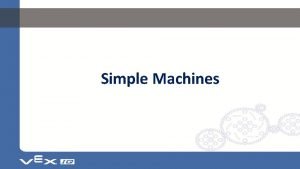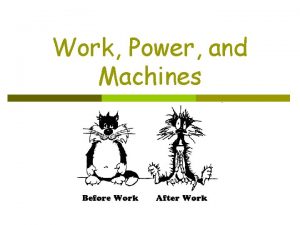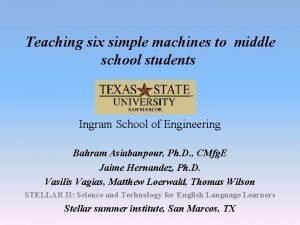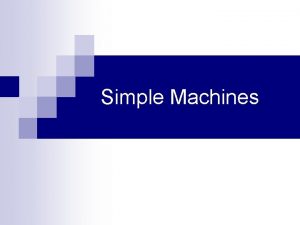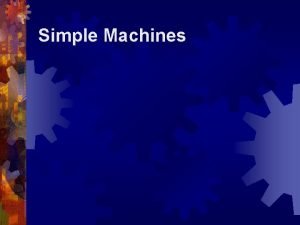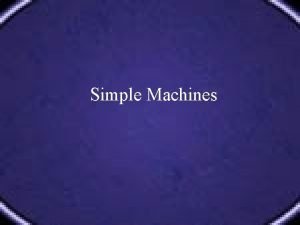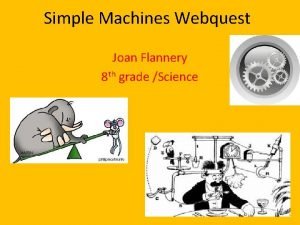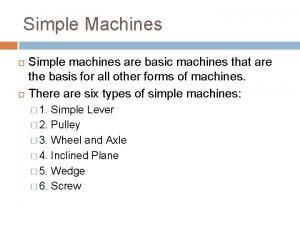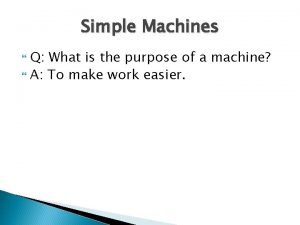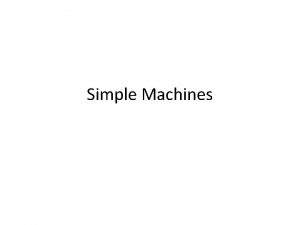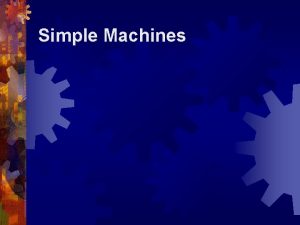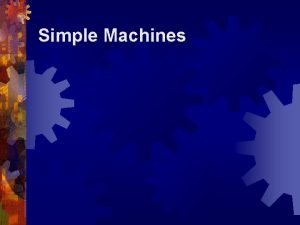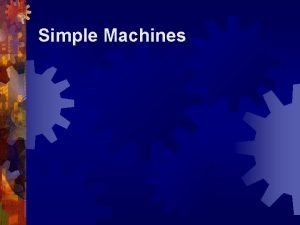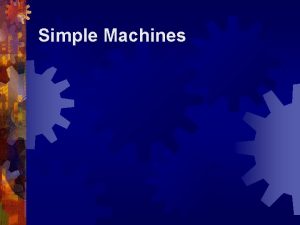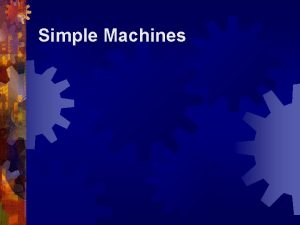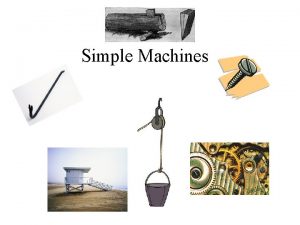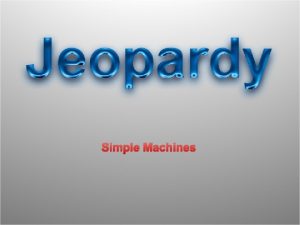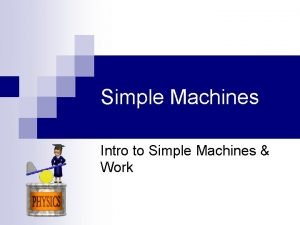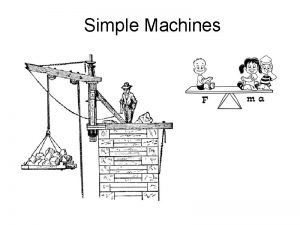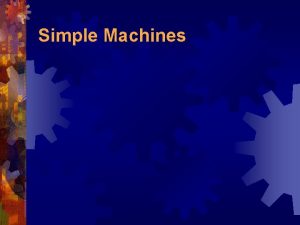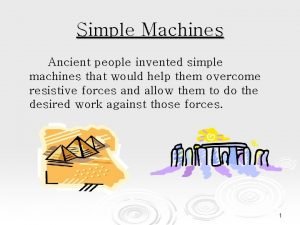Simple Machines SIMPLE MACHINES Simple Machines are tools


















- Slides: 18

Simple Machines

SIMPLE MACHINES Simple Machines are tools used to make work easier. In science, work is defined as a force acting on an object to move it across a distance. Pushing, pulling, and lifting are common forms of work. A force is any push or pull that causes an object to change its position (movement), direction, or shape.

SIMPLE MACHINES Wheel & Axle - Makes work easier by moving objects across distances. The wheel, the round end, turns with the axle, the cylindrical post, causing movement. On a wagon, for example, a container rests on top of the axle. Inclined Plane - A flat surface (or plane) that is slanted, or inclined, so it can help move objects across distances. A common inclined plane is a ramp. Wedge - Instead of using the smooth side of the inclined plane to make work easier, you can also use the pointed edges to do other kinds of work. For example, you can use the edge to push things apart. Then, this movable inclined plane is a wedge. An axe blade is one example of a wedge. Lever - Any tool that pries something loose is a lever. Levers can also lift objects. A lever is an arm that “pivots” (or turns) against a fulcrum (the point or support on which a lever pivots). Think of the claw end of a hammer that you use to pry nails loose. It’s a lever. A see-saw is also a lever.

SIMPLE MACHINES Pulley - Instead of an axle, a wheel could also rotate a rope, cord, or belt. This variation of the wheel and axle is the pulley. In a pulley, a cord wraps around a wheel. As the wheel rotates, the cord moves in either direction. Now, attach a hook to the cord, and you can use the wheel’s rotation to raise and lower objects making work easier. On a flagpole, for example, a rope is attached to a pulley to raise and lower the flag more easily. Screw -Take an inclined plane and wrap it around a cylinder. Its sharp edge becomes another simple tool: a screw. Put a metal screw beside a ramp and it’s hard to see similarities, but a screw is actually just another kind of inclined plane. One example of how a screw helps you do work is that it is easily turned to move itself through a solid space like a block of wood.

Simple Machines Mechanisms that manipulate magnitude of force and distance. Lever Wheel and Axle Pulley

The Six Simple Machines Inclined Plane Wedge Screw

Mechanical Advantage (MA) • Ratio of the magnitude of the resistance and effort forces • Ratio of distance traveled by the effort and the resistance force Calculated ratios allow designers to manipulate speed, distance, force, and function MAKES WORK EASY

Work The product of the effort times the distance traveled will be the same regardless of the system mechanical advantage

Work The force applied on an object times distance the object travels parallel to the force Initial position Force (F) Final position Parallel Distance (d║) Work = Force · Distance = F · d║

Lever A rigid bar used to exert a pressure or sustain a weight at one point of its length by the application of a force at a second point and turning on a fulcrum at a third.

First Class Lever Fulcrum is located between the effort and the resistance forces. Effort and resistance forces are applied to the lever arm in the same direction. Only class of lever that can have an MA greater than or less than 1. Resistance Effort MA =1 Resistance Effort MA <1 Resistance Effort MA >1

Moment The turning effect of a force about a point equal to the magnitude of the force times the perpendicular distance from the point to the line of action from the force. M = dx. F Torque: A force that produces or tends to produce rotation or torsion.

Lever Moment Calculation 15 lb 5. 5 in. Resistance 15 lbs Effort Calculate the effort moment acting on the lever. M=dx. F Effort Moment = 5. 5 in. x 15 lb Effort Moment = 82. 5 in. lb

Lever Moment Calculation When the sum of all moments on a lever equals 0, the lever is in rotational equilibrium. Rotational Equilibrium The state in which the sum of all the clockwise moments equals the sum of all the counterclockwise moments about a pivot point.

Wheel and Axle A wheel is a lever arm fixed to a shaft, called an axle. The wheel and axle move together as a simple lever to lift or move an item by rolling. It is important to know which is applying the effort and resistance force – wheel or axle. Can you think of an example of a wheel driving an axle?

Pulley A pulley is a lever consisting of a wheel with a groove in its rim that is used to change the direction and magnitude of a force exerted by a rope or cable.

LESSON 04 PLENARY As a class, let us consider the following questions? A. How many of the 6 types of machine mechanisms can you name? B. What is the purpose of a mechanism? C. What is friction? D. What is any push or pull that causes an object to change its position, direction, or shape. ?

SUMMARY Learning objective: Be able to identify the six types of simple machines visually. Learn key terminology related to motion and the use of simple machines. Learn how simple machines make work easier. Today you have: § Been able to identify the six types of simple machines visually. § Learnt key terminology related to motion and the use of simple machines. § Learnt how simple machines make work easier.
 Antigentest åre
Antigentest åre Simple machines tools
Simple machines tools Cutting tools in sewing with pictures and meaning
Cutting tools in sewing with pictures and meaning How to make simple electrical gadgets
How to make simple electrical gadgets Find the efficiency of a machine that does 800 j
Find the efficiency of a machine that does 800 j Maybe shes born with it slogan
Maybe shes born with it slogan Different types of wedges simple machines
Different types of wedges simple machines Inclined plane examples
Inclined plane examples Examples of simple machines
Examples of simple machines Simple vs compound machines
Simple vs compound machines Lawn mower simple machine
Lawn mower simple machine Simple machine webquest
Simple machine webquest Define compound machines
Define compound machines All types of simple machines
All types of simple machines What are the six types of simple machines
What are the six types of simple machines Simple machine review
Simple machine review Describe three purposes of using simple machines
Describe three purposes of using simple machines Type of simple machine
Type of simple machine Examples of screw
Examples of screw

